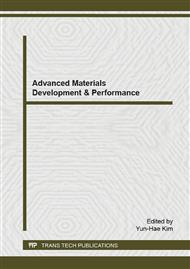[1]
B. Yang, C. T. Liu, T. G Nieh, Unified equation for the strength of bulk metallic glasses, App. Phys. Lett. 88 (2006) 221911-3.
Google Scholar
[2]
H.S. Chen, Glassy metals, Rep. Phys. 43 (1980) 352-432.
Google Scholar
[3]
A. Inoue, W. Zhang, T. Zhang, K. Kurosaka, High-strength Cu-based bulk glassy alloys in Cu-Zr-Ti and Cu-Hf-Ti ternary systems, Acta Mater. 49 (2001) 2645-2652.
DOI: 10.1016/s1359-6454(01)00181-1
Google Scholar
[4]
W.H. Wang, Roles of minor additions in formation and properties of bulk metallic glasses, Prog. Mater. Sci. 52 (2007) 540-596.
DOI: 10.1016/j.pmatsci.2006.07.003
Google Scholar
[5]
F. Liu, S. Pang, R. Li, T. Zhang, Ductile Fe-Mo-P-C-B-Si bulk metallic glasses with high saturation magnetization, J. Alloys. Compd. 483 (2009) 613-615.
DOI: 10.1016/j.jallcom.2008.07.164
Google Scholar
[6]
H.X. Li, S.L. Wang, S. Yi, Z.B. Jialo, Y. Wu, Z.P. Lu, Glass formation and magnetic properties of Fe-C-Si-B-P-(Cr-Al-Co) bulk metallic glasses fabricated using industrial raw materials, J. Magn. Magn. Mater. 321 (2009) 2833-2837.
DOI: 10.1016/j.jmmm.2009.04.021
Google Scholar
[7]
F. Liu, Q. Yang, S. Pang, T. Zhang, Effect of Mo element on the properties of Fe-Mo-P-C-B bulk metallic glasses, J. of Non-Cryst. Solids 355 (2009) 1444-1447.
DOI: 10.1016/j.jnoncrysol.2009.05.048
Google Scholar
[8]
Z.B. Jiao, H.X. Li, W.U. Yuan, J.E. Gao, S.L. Wang, S. Yi, Z.P. Lu, Effects of Mo additions on the glass-forming ability and magentic properties of bulk amorphous Fe-C-Si-B-P-Mo alloys, China Phys. Mech. Astron. 53 (2010) 430-434.
DOI: 10.1007/s11433-010-0135-9
Google Scholar
[9]
K. Miyoshi, D.H. Buckley, Friction and wear of some ferrous-base metallic glasses, ASLE Transactions 27 (4) (1984) 295-304.
DOI: 10.1080/05698198408981574
Google Scholar
[10]
B. Prakash and K. Hiratshka, Sliding wear behavior of some Fe-, Co- and Ni-based metallic glasses during rubbing against bearing steel, Tribol. Lett. 8 (2000) 153-160.
Google Scholar
[11]
D. Huang, Ran Li, Lu Huang, V. Ji, T. Zhang, Fretting wear behavior of bulk amorphous steel, Intermetallics 19 (2011) 1385-1389.
DOI: 10.1016/j.intermet.2011.04.014
Google Scholar
[12]
D.R. Maddala, R.J. Hebert, Sliding wear behavior of Fe50-xCr15Mo14C15B6Erx(x=0, 1, 2 at%) bulk metallic glass, Wear 294-295 (2012) 246-256.
DOI: 10.1016/j.wear.2012.06.007
Google Scholar
[13]
Z.B. Jiao, H.X. Li, J.E. Gao, Y. Wu, Z.P. Lu, Effects of alloying elements on glass formation, mechanical and soft-magnetic properties of Fe-bsed metallic glasses, Intermetallics 19 (2011) 1502-1508.
DOI: 10.1016/j.intermet.2011.05.020
Google Scholar
[14]
I. Radu, D.Y. Li, R. Llewellyn, Tribological behavior of Stellite 21 modified with yttrium, Wear 257 (2004) 1154-1166.
DOI: 10.1016/j.wear.2004.07.013
Google Scholar
[15]
M. Stoica, J. Eckert, S. Roth, Z.F. Zhang, L. Schultz, W.H. Wang, Mechanical behavior of Fe65. 5Cr4Mo4Ga4P12C5B5. 5, Intermetallics 13 (2005) 764-769.
DOI: 10.1016/j.intermet.2004.12.016
Google Scholar
[16]
W.C. Oliver, G.M. Pharr, An improved technique for determining hardness and elastic modulus using load and displacement sensing indentation experiments, J. Mater. Res. 7 (1992) 1564-1583.
DOI: 10.1557/jmr.1992.1564
Google Scholar
[17]
R. Vaidyanathan, M. Dao, G. Ravichandran, S. Suresh, Study of mechanical deformation in bulk metallic glass through instrumented indentation, Acta Mater. 49 (2001) 3781-3789.
DOI: 10.1016/s1359-6454(01)00263-4
Google Scholar
[18]
E. Martinez, J. Romero, A. Lousa, J. Esteve, Nanoindentation stress-strain curves as a method for thin-film complete mechanical characterization: application to nanometric CrN/Cr multilayer coatings, Appl. Phys. A 77 (2003) 419-426.
DOI: 10.1007/s00339-002-1669-0
Google Scholar


